2002 SUBARU FORESTER wheel
[x] Cancel search: wheelPage 272 of 466
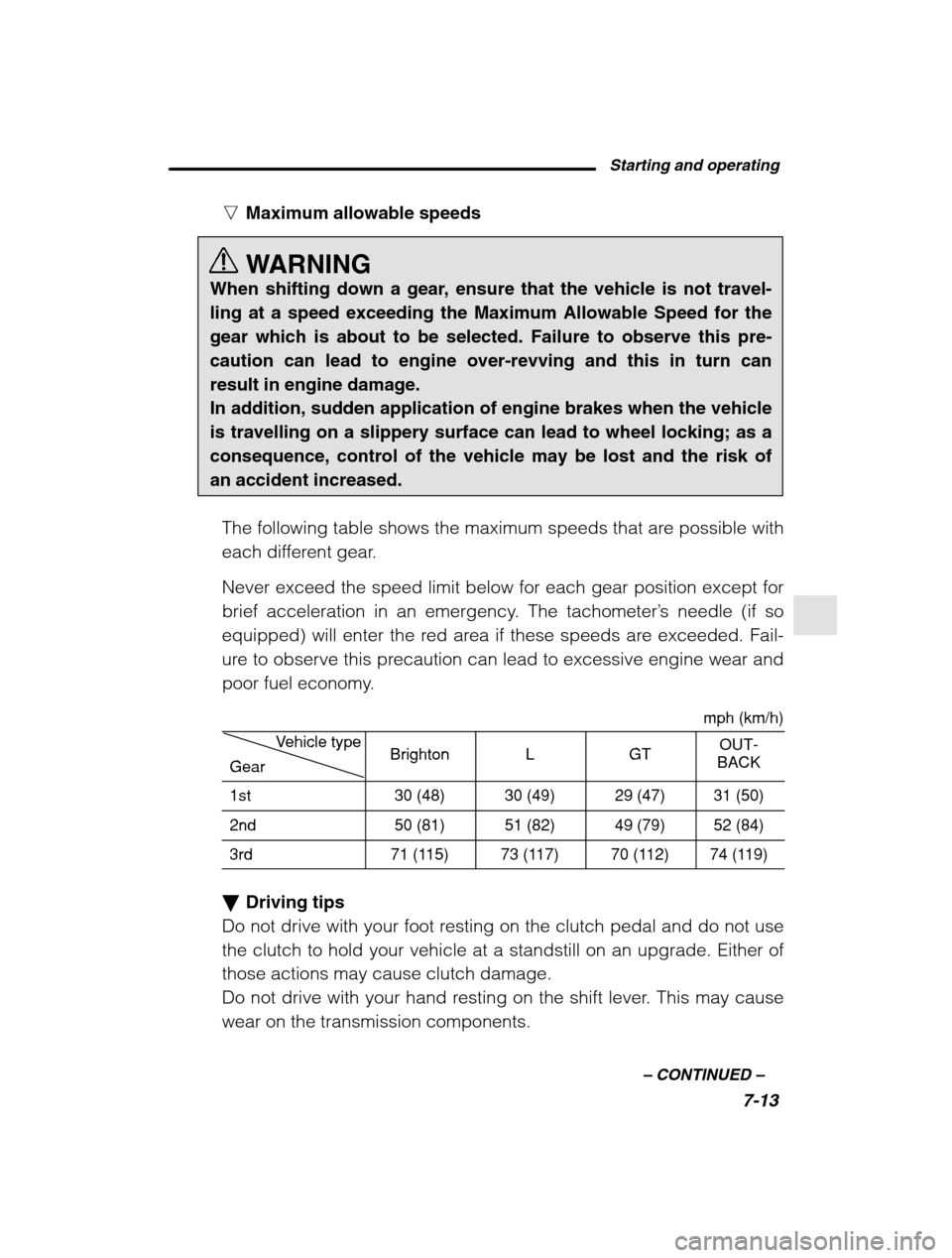
Starting and operating7-13
–
CONTINUED –
nMaximum allowable speeds
WARNING
When shifting down a gear, ensure that the vehicle is not travel- ling at a speed exceeding the Maximum Allowable Speed for thegear which is about to be selected. Failure to observe this pre-caution can lead to engine over-revving and this in turn canresult in engine damage.In addition, sudden application of engine brakes when the vehicleis travelling on a slippery surface can lead to wheel locking; as a
consequence, control of the vehicle may be lost and the risk ofan accident increased.
The following table shows the maximum speeds that are possible with
each different gear. Never exceed the speed limit below for each gear position except for
brief acceleration in an emergency. The tachometer ’s needle (if so
equipped) will enter the red area if these speeds are exceeded. Fail-
ure to observe this precaution can lead to excessive engine wear and
poor fuel economy.
mph (km/h)
Vehicle type
GearBrightonLGTOUT-
BACK
1st30 (48)30 (49)29 (47)31 (50)
2nd50 (81)51 (82)49 (79)52 (84)
3rd71 (115)73 (117)70 (112)74 (119)
� Driving tips
Do not drive with your foot resting on the clutch pedal and do not use the clutch to hold your vehicle at a standstill on an upgrade. Either ofthose actions may cause clutch damage.
Do not drive with your hand resting on the shift lever. This may causewear on the transmission components.
Page 275 of 466
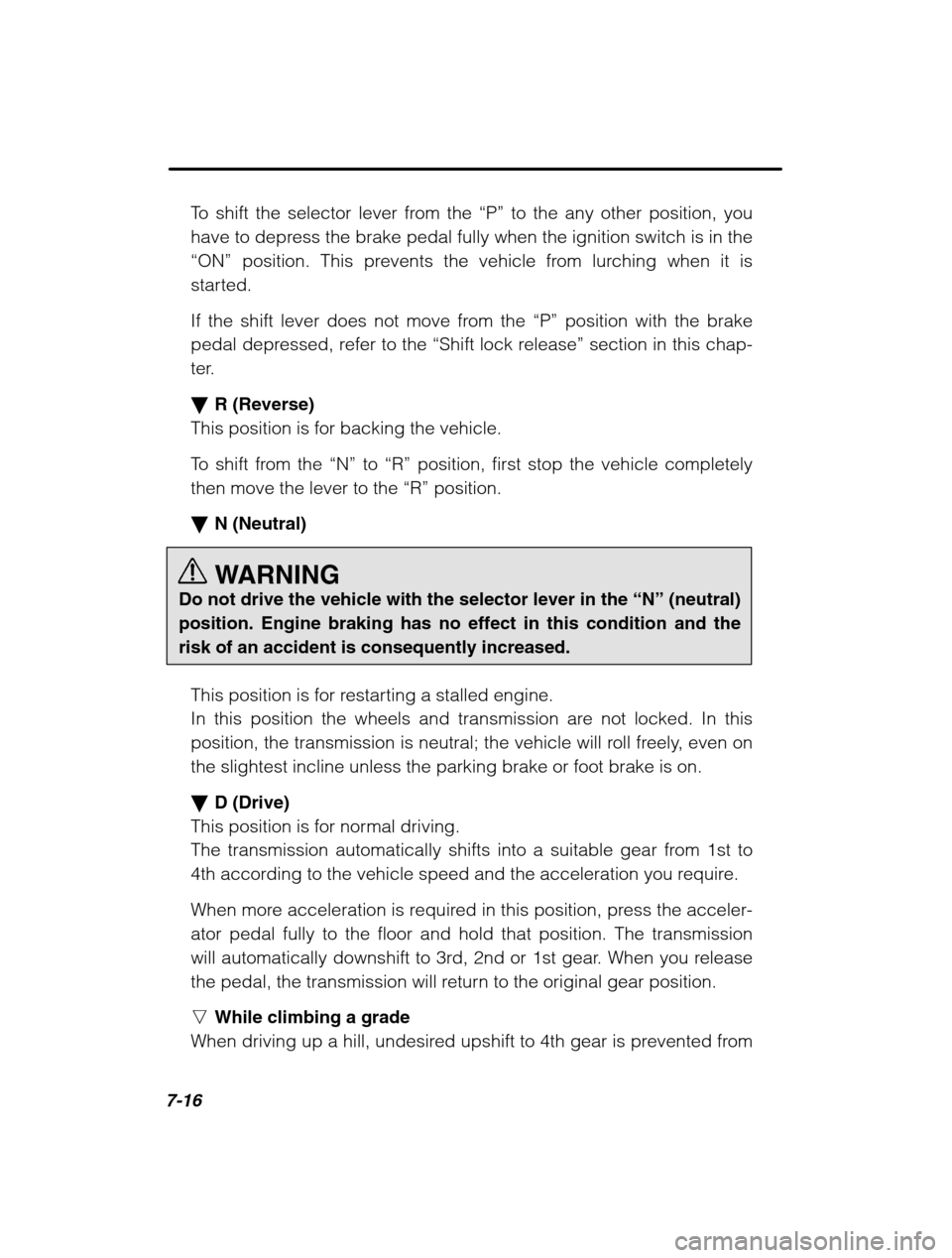
7-16
To shift the selector lever from the “P” to the any other position, you
have to depress the brake pedal fully when the ignition switch is in the
“ON” position. This prevents the vehicle from lurching when it is
started.
If the shift lever does not move from the “P” position with the brake
pedal depressed, refer to the “Shift lock release ” section in this chap-
ter. � R (Reverse)
This position is for backing the vehicle.
To shift from the “N” to “R” position, first stop the vehicle completely
then move the lever to the “R” position.
� N (Neutral)
WARNING
Do not drive the vehicle with the selector lever in the “N” (neutral)
position. Engine braking has no effect in this condition and the risk of an accident is consequently increased.
This position is for restarting a stalled engine.
In this position the wheels and transmission are not locked. In this
position, the transmission is neutral; the vehicle will roll freely, even onthe slightest incline unless the parking brake or foot brake is on. � D (Drive)
This position is for normal driving.
The transmission automatically shifts into a suitable gear from 1st to
4th according to the vehicle speed and the acceleration you require.
When more acceleration is required in this position, press the acceler- ator pedal fully to the floor and hold that position. The transmission
will automatically downshift to 3rd, 2nd or 1st gear. When you release
the pedal, the transmission will return to the original gear position. n While climbing a grade
When driving up a hill, undesired upshift to 4th gear is prevented from
Page 277 of 466
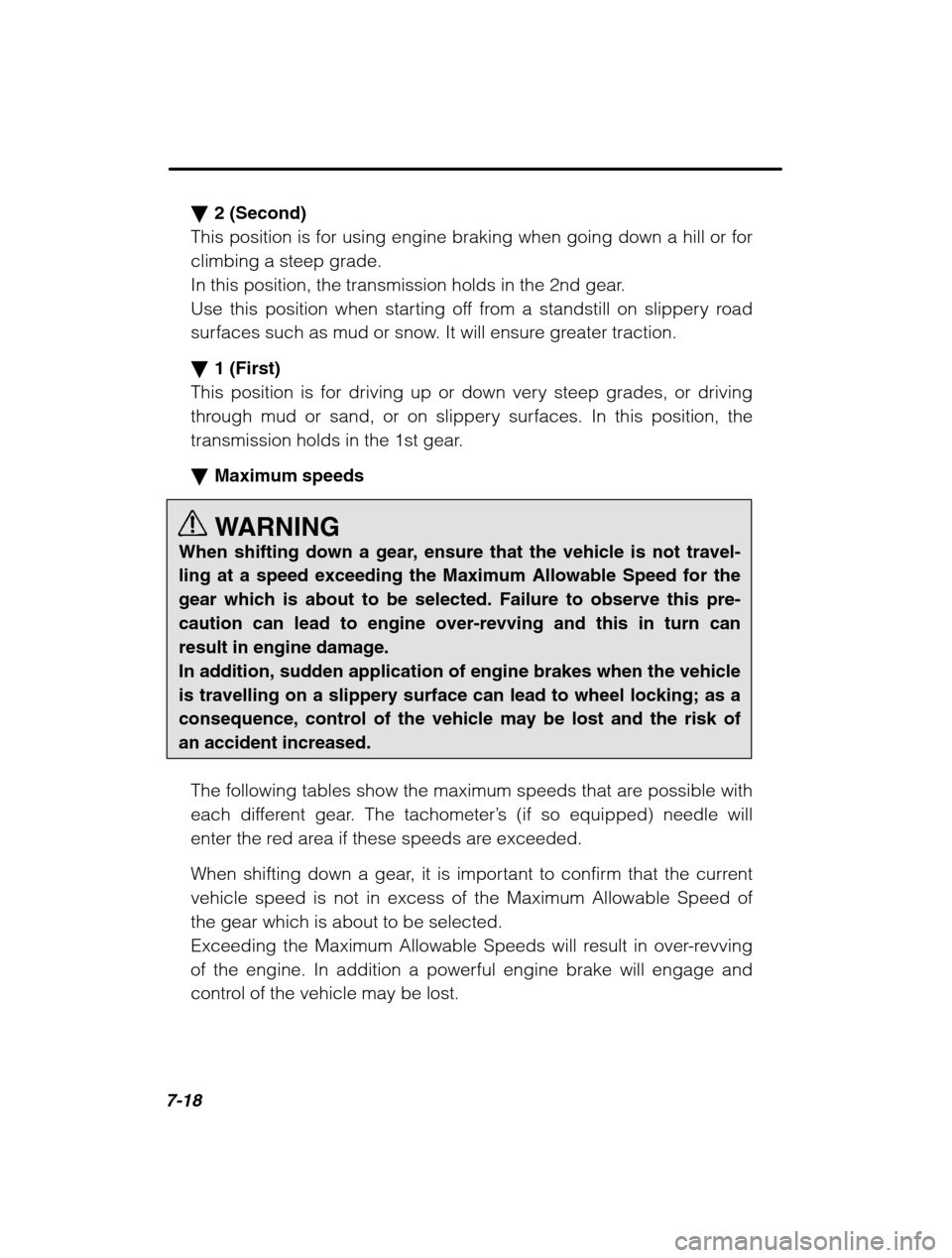
7-18
�2 (Second)
This position is for using engine braking when going down a hill or for
climbing a steep grade.
In this position, the transmission holds in the 2nd gear.
Use this position when starting off from a standstill on slippery road
surfaces such as mud or snow. It will ensure greater traction. � 1 (First)
This position is for driving up or down very steep grades, or driving
through mud or sand, or on slippery surfaces. In this position, the
transmission holds in the 1st gear. � Maximum speeds
WARNING
When shifting down a gear, ensure that the vehicle is not travel- ling at a speed exceeding the Maximum Allowable Speed for thegear which is about to be selected. Failure to observe this pre-caution can lead to engine over-revving and this in turn canresult in engine damage.In addition, sudden application of engine brakes when the vehicleis travelling on a slippery surface can lead to wheel locking; as a
consequence, control of the vehicle may be lost and the risk ofan accident increased.
The following tables show the maximum speeds that are possible with
each different gear. The tachometer ’s (if so equipped) needle will
enter the red area if these speeds are exceeded.
When shifting down a gear, it is important to confirm that the current
vehicle speed is not in excess of the Maximum Allowable Speed ofthe gear which is about to be selected.
Exceeding the Maximum Allowable Speeds will result in over-revving
of the engine. In addition a powerful engine brake will engage and
control of the vehicle may be lost.
Page 279 of 466
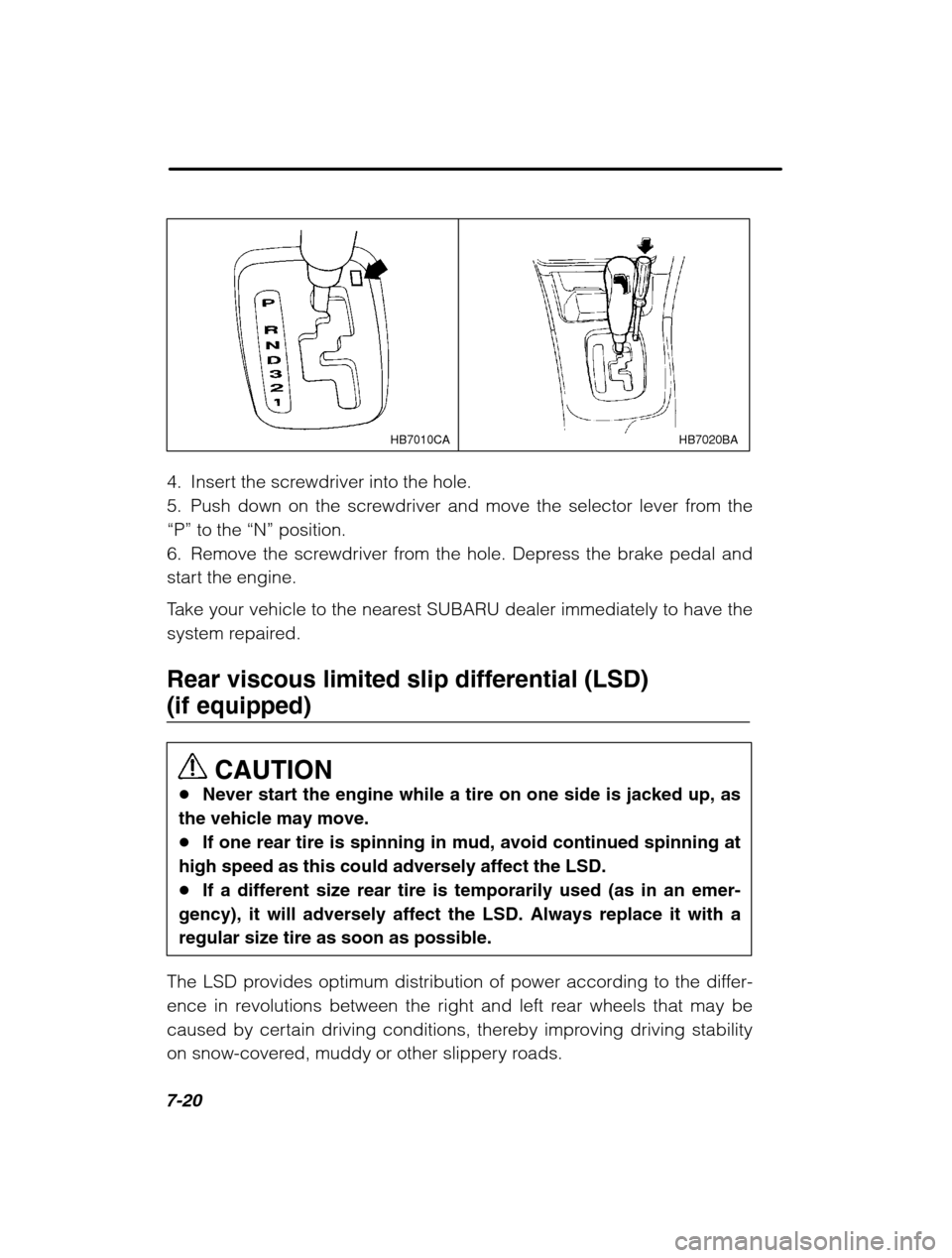
7-20
HB7020BA
HB7010CA
4. Insert the screwdriver into the hole.
5. Push down on the screwdriver and move the selector lever from the“P” to the “N” position.
6. Remove the screwdriver from the hole. Depress the brake pedal and
start the engine.
Take your vehicle to the nearest SUBARU dealer immediately to have the
system repaired.
Rear viscous limited slip differential (LSD) (if equipped)
CAUTION
� Never start the engine while a tire on one side is jacked up, as
the vehicle may move. � If one rear tire is spinning in mud, avoid continued spinning at
high speed as this could adversely affect the LSD.� If a different size rear tire is temporarily used (as in an emer-
gency), it will adversely affect the LSD. Always replace it with aregular size tire as soon as possible.
The LSD provides optimum distribution of power according to the differ-
ence in revolutions between the right and left rear wheels that may be
caused by certain driving conditions, thereby improving driving stability
on snow-covered, muddy or other slippery roads.
Page 280 of 466
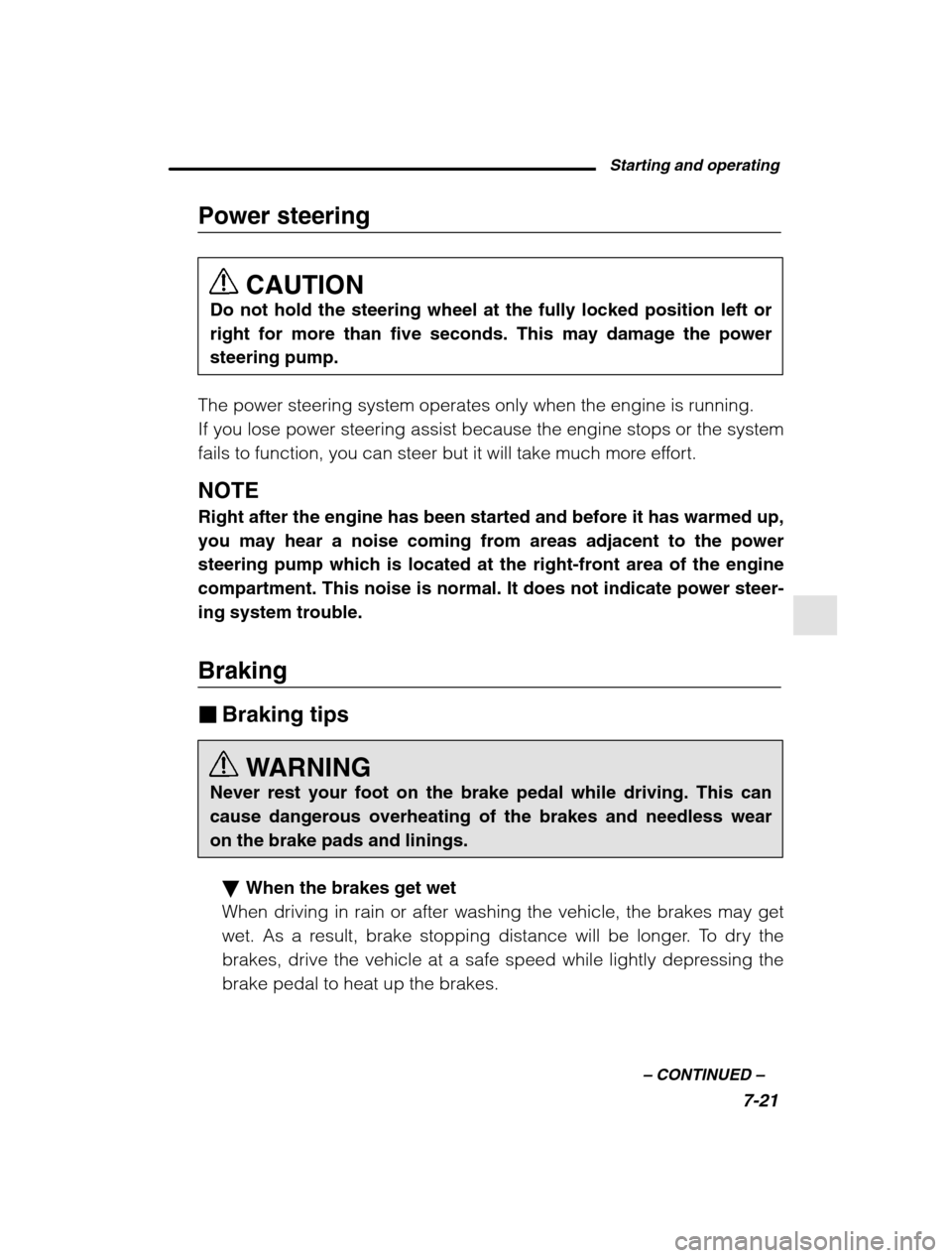
Starting and operating7-21
–
CONTINUED –
Power steering
CAUTION
Do not hold the steering wheel at the fully locked position left or right for more than five seconds. This may damage the powersteering pump.
The power steering system operates only when the engine is running.
If you lose power steering assist because the engine stops or the system
fails to function, you can steer but it will take much more effort. NOTE Right after the engine has been started and before it has warmed up, you may hear a noise coming from areas adjacent to the powersteering pump which is located at the right-front area of the enginecompartment. This noise is normal. It does not indicate power steer-ing system trouble. Braking � Braking tips
WARNING
Never rest your foot on the brake pedal while driving. This can
cause dangerous overheating of the brakes and needless wearon the brake pads and linings.
� When the brakes get wet
When driving in rain or after washing the vehicle, the brakes may get
wet. As a result, brake stopping distance will be longer. To dry the
brakes, drive the vehicle at a safe speed while lightly depressing thebrake pedal to heat up the brakes.
Page 283 of 466
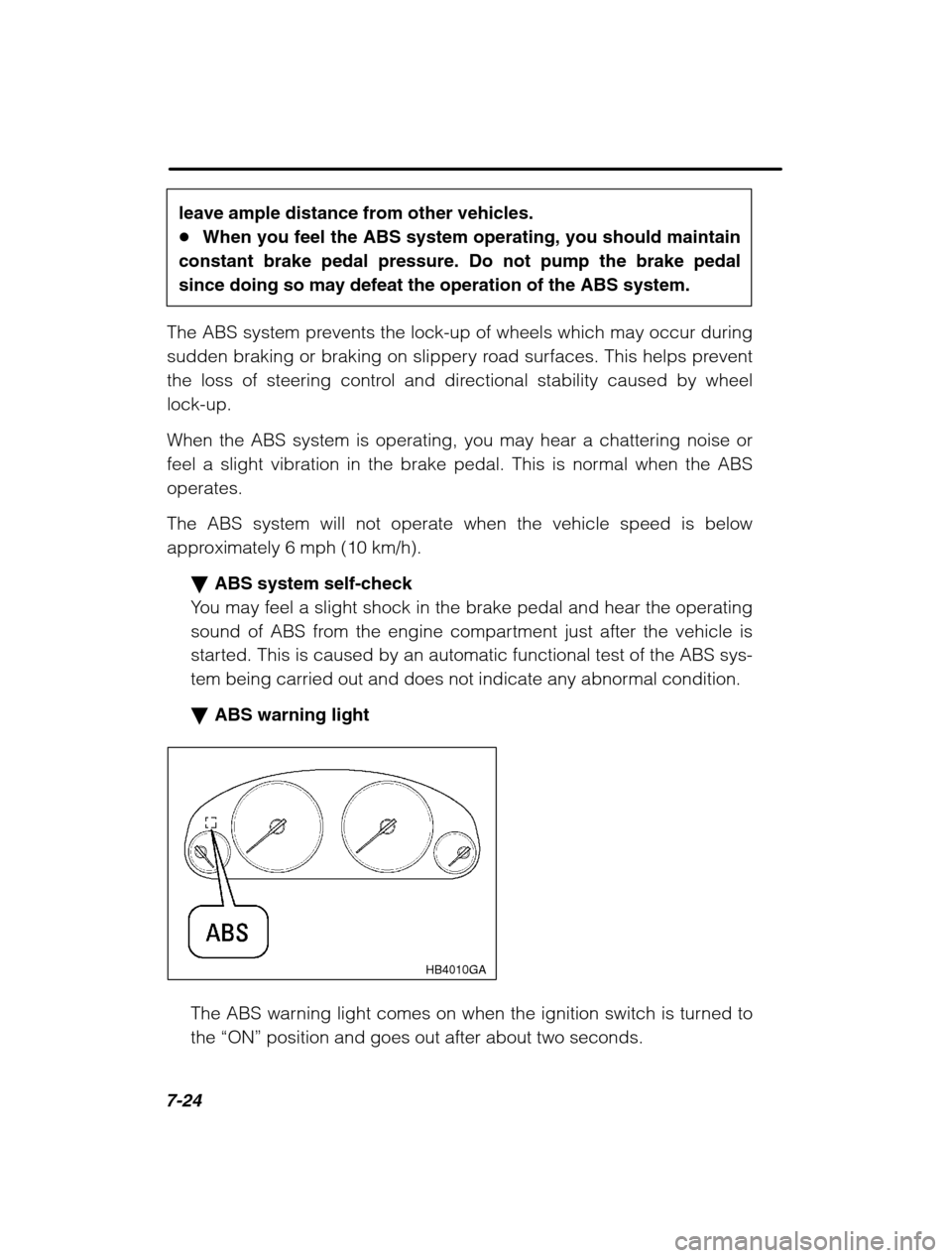
7-24
leave ample distance from other vehicles. �When you feel the ABS system operating, you should maintain
constant brake pedal pressure. Do not pump the brake pedal
since doing so may defeat the operation of the ABS system.
The ABS system prevents the lock-up of wheels which may occur during
sudden braking or braking on slippery road surfaces. This helps prevent
the loss of steering control and directional stability caused by wheellock-up.
When the ABS system is operating, you may hear a chattering noise or
feel a slight vibration in the brake pedal. This is normal when the ABSoperates. The ABS system will not operate when the vehicle speed is below
approximately 6 mph (10 km/h). � ABS system self-check
You may feel a slight shock in the brake pedal and hear the operating
sound of ABS from the engine compartment just after the vehicle is
started. This is caused by an automatic functional test of the ABS sys-
tem being carried out and does not indicate any abnormal condition. � ABS warning light
HB4010GA
The ABS warning light comes on when the ignition switch is turned to the “ON” position and goes out after about two seconds.
Page 285 of 466

7-26
VDC (Vehicle Dynamics Control) system (if equipped)WARNING
Always use the utmost care in driving — overconfidence because
you are driving with a VDC system equipped vehicle could easily lead to a serious accident.
CAUTION
� Even if your vehicle is equipped with VDC, winter tires should
be used when driving on snow-covered or icy roads; in addition,
vehicle speed should be reduced considerably. Simply having a
VDC system does not guarantee that the vehicle will be able toavoid accidents in any situation.� Activation of the VDC system is an indication that the road
being travelled on has a slippery surface; since having VDC is no
guarantee that full vehicle control will be maintained at all timesand under all conditions, its activation should be seen as a sign
that the speed of the vehicle should be reduced considerably.� Whenever suspension components, steering components, or
an axle are removed from a vehicle equipped with VDC, have anauthorized SUBARU dealer perform an inspection of that system.� The following precautions should be observed in order to
ensure that the VDC system is operating properly:
–All four wheels should be fitted with tires of the same size,
type, and brand. Furthermore, the amount of wear should bethe same for all four tires.– Keep the tire pressure at the proper level as shown on the
label attached to the vehicle ’s door pillar.
– Use only the special temporary spare tire to replace a flat
tire. With a temporary spare tire, the effectiveness of the VDC
system is reduced and this should be taken into account whendriving with vehicle.
Page 286 of 466
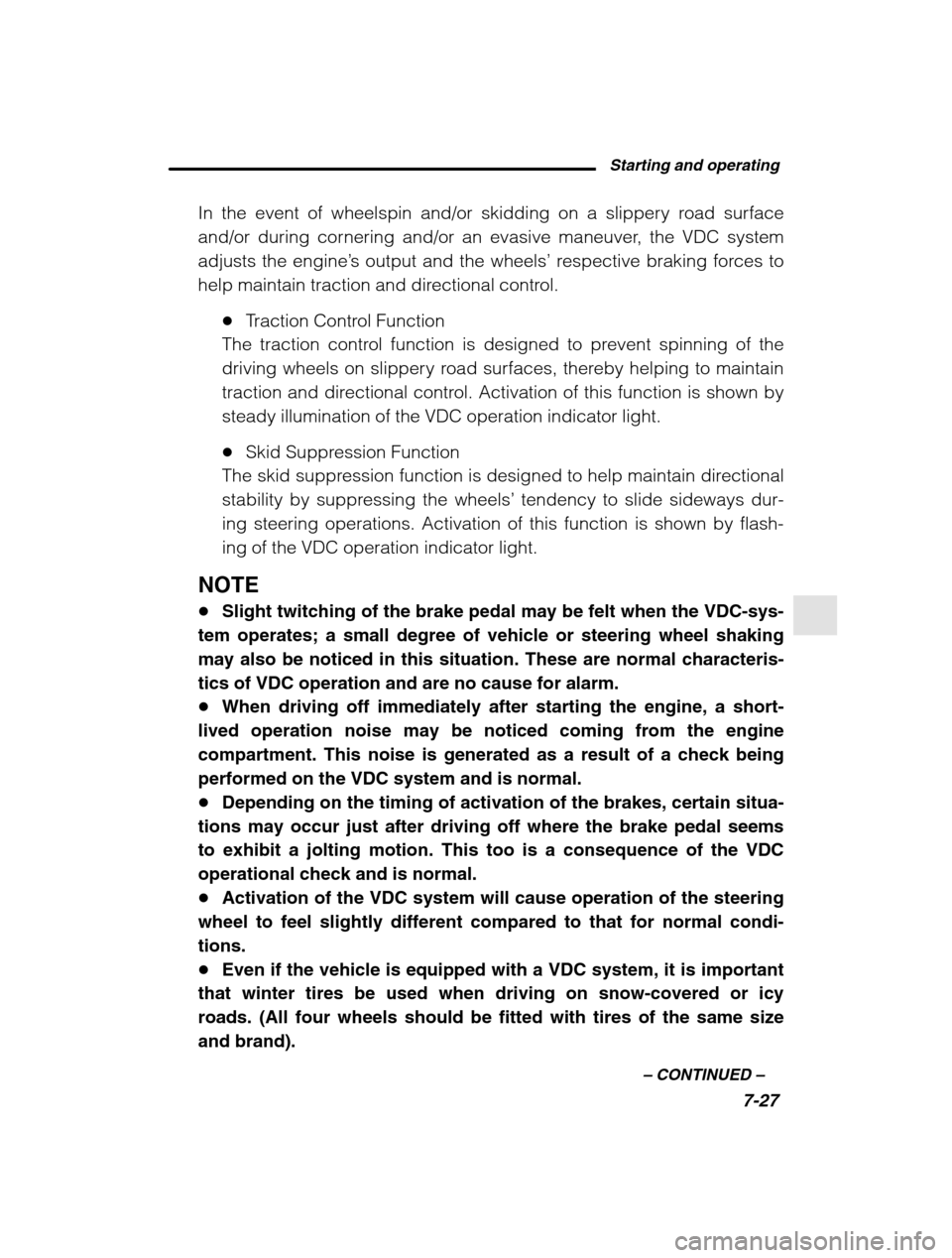
Starting and operating7-27
–
CONTINUED –
In the event of wheelspin and/or skidding on a slippery road surface
and/or during cornering and/or an evasive maneuver, the VDC systemadjusts the engine ’s output and the wheels ’ respective braking forces to
help maintain traction and directional control.
�Traction Control Function
The traction control function is designed to prevent spinning of the
driving wheels on slippery road surfaces, thereby helping to maintain
traction and directional control. Activation of this function is shown bysteady illumination of the VDC operation indicator light. � Skid Suppression Function
The skid suppression function is designed to help maintain directional
stability by suppressing the wheels ’ tendency to slide sideways dur-
ing steering operations. Activation of this function is shown by flash-ing of the VDC operation indicator light.
NOTE � Slight twitching of the brake pedal may be felt when the VDC-sys-
tem operates; a small degree of vehicle or steering wheel shaking may also be noticed in this situation. These are normal characteris-tics of VDC operation and are no cause for alarm.� When driving off immediately after starting the engine, a short-
lived operation noise may be noticed coming from the enginecompartment. This noise is generated as a result of a check beingperformed on the VDC system and is normal.� Depending on the timing of activation of the brakes, certain situa-
tions may occur just after driving off where the brake pedal seemsto exhibit a jolting motion. This too is a consequence of the VDCoperational check and is normal.� Activation of the VDC system will cause operation of the steering
wheel to feel slightly different compared to that for normal condi-tions.� Even if the vehicle is equipped with a VDC system, it is important
that winter tires be used when driving on snow-covered or icyroads. (All four wheels should be fitted with tires of the same sizeand brand).